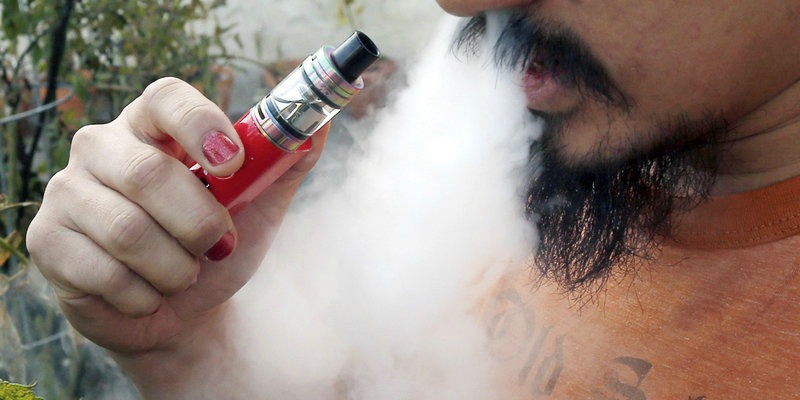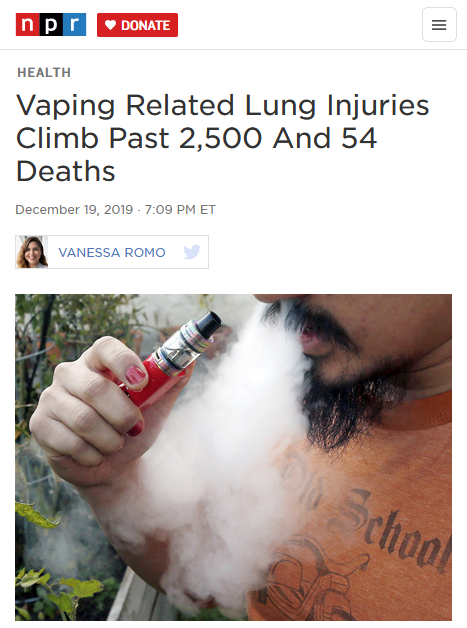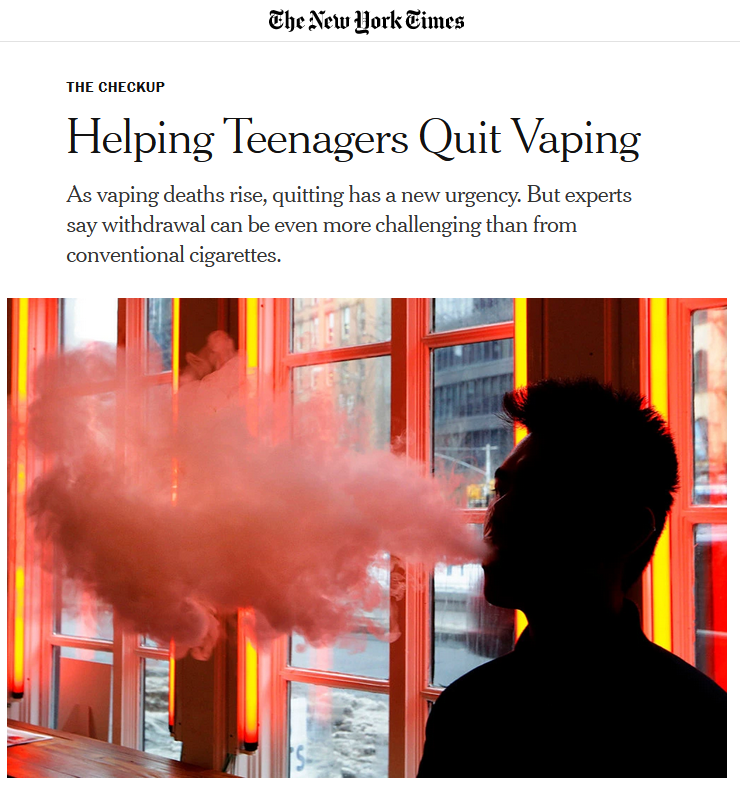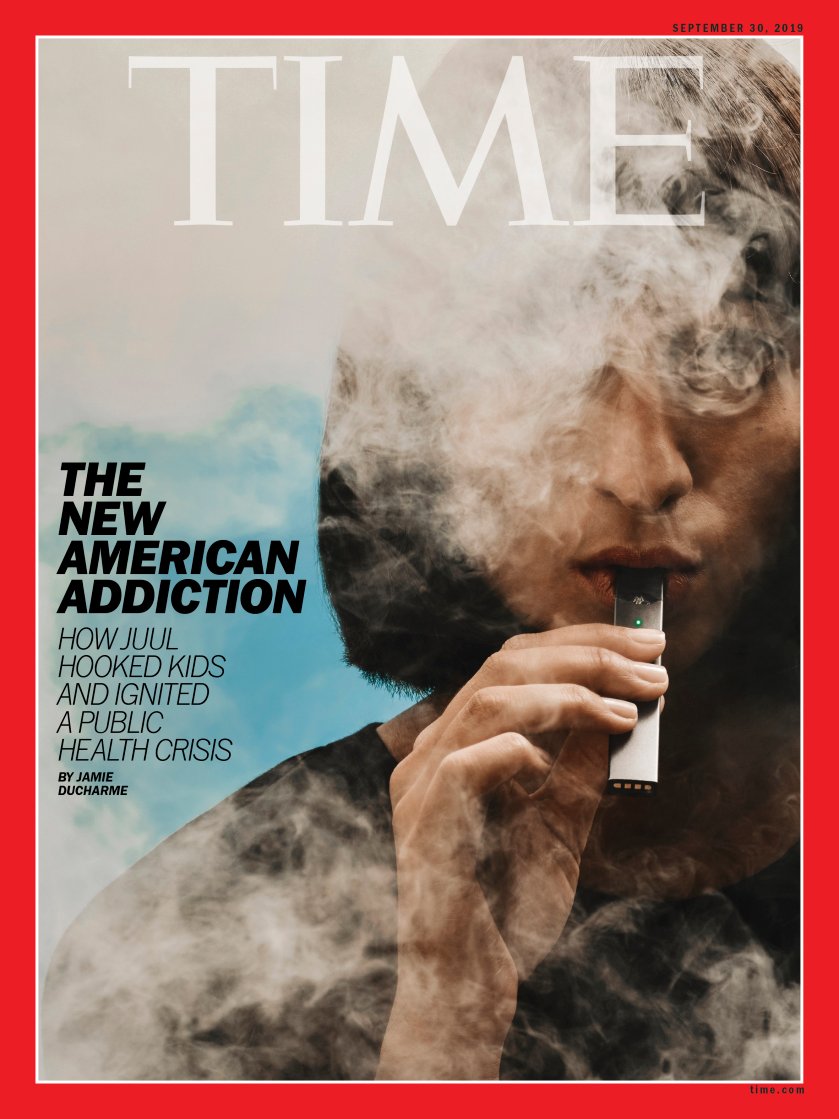Media Vapors Over Vaping Cloud Public Health Goals
Teddy Ostrow

by Teddy Ostrow

The "vaping-related" injuries in NPR's headline (12/19/19) are not caused by e-cigarettes like the one in NPR's photo.
Take the flurry of reports last summer warning of a “mysterious lung disease,” confirmed as of December to be injuries stemming from vaping black-market THC oil contaminated with vitamin E acetate. Media leapt on the case with an urgency that extended months: “Teen Who Was First New Yorker to Die of Vaping-Related Illness Named” ( New York Post, 12/18/19), “Vaping-Related Lung Injuries Climb Past 2,500 and 54 Deaths” ( NPR, 12/19/19), “Michigan 2nd Vaping-Related Death” ( Boston Globe, 12/2/19).
New York magazine ( 10/4/19) gave us “The Horror Stories From the Vaping Crisis Are Getting Worse,” including reference to a New York Times article ( 10/2/19) in which the recent lung injuries were compared to World War I mustard gas attacks.
Vaping, of course, is a system of delivery, not a substance itself. Accounts of "horrifying" and "terrifying" injuries succeeded in alarming readers, while leaving them none the wiser about what exactly people were vaping that was putting them in the hospital.
In fact, people vaping black-market THC might have assumed they were in the clear, as media coverage clearly pointed to nicotine vaping as the culprit. Images accompanying stories on the "crisis" (e.g., NBC News, 12/19/19; NewsHour, 9/19/19; NPR, 9/18/19) were of nicotine vape mods, pens and, of course, the infamous Juul, poking out of thick clouds of nicotine vapor. It’s no wonder that one poll at the height of the panic last year showed that close to two-thirds of American adults—up from just under half in 2018—believe that vaping e-cigs is not less harmful than smoking combustible tobacco.

The New York Times (10/14/19) uses deaths from vaping black-market THC to hype the "urgency" of quitting nicotine vaping.
Other articles carried misleading headlines or subheadlines, such as “After Deaths, Ban on Flavored Vapes to Be Passed by New York City” ( New York Times, 11/21/19), implying a logical connection between the deaths and the flavored (nicotine) vapes being banned; or “As Vaping Deaths Rise, Quitting Has a New Urgency” ( New York Times, 10/14/19), over a story that leaps from “ increasing reports of serious illness, lung damage and death related to vaping” to the need to “help an adolescent or a young adult shake a nicotine habit.” Most irresponsibly, both cases, and others like them (e.g., Wall Street Journal, 12/18/19), fail to even mention the developing link to black-market THC in the text.
Initially, the CDC, the Food and Drug Administration (FDA) and other health authorities advised the nation to cease all vaping. Media dutifully reported the recommendations, while mostly ignoring skeptics like community health professor Michael Siegel of Boston University, who put such calls into perspective ( Rest of the Story, 9/27/19):
This is like reporting a series of deaths from eating Romaine lettuce and advising people to immediately stop eating all lettuce and cabbage. Except it's a lot worse, because no harm comes from people stopping eating cabbage. Severe harm is already resulting from ex-smokers stopping vaping and returning to smoking, or to the black market.
In some ways, the moral panic around vaping echoes earlier media-abetted scares. But unlike the overt racism of reporting on "opium dens" or "crackhouses" that saw drug users as sources of societal contagion, elite media see vaping itself as a scourge, invading and perverting wholesome (suburban) children.

Time (9/30/19) warns that Juul "hooked kids and ignited a public health crisis."
This is on display in Time magazine’s September 30 cover story, headlined “The New American Addiction”—subtitled “How Juul Hooked Kids and Ignited a Public Health Crisis”—and in the New York Times’ November 23 web feature, “How Juul Hooked a Generation on Nicotine.”
Loaded terms like “hooked” and “kids”—along with references to an “epidemic on speed” ( Time, 9/30/19) —do a lot of work for reporters. But statistics hardly show that “a generation” (a buzzword for young white people) is becoming addicted to nicotine through vaping—and particularly not pre-teens, the age group implied and weaponized by media with the term “kids,” another word that draws images of white, innocent children in US media. I spoke to numerous public health experts for The Nation ( 12/27/19), most of whom insisted that the vast majority of young people’s e-cig use is experimental.
Genuine concerns, in any event, would be better met by harm reduction than exaggeration or fearmongering. The Harm Reduction Coalition defines it as “a set of practical strategies and ideas aimed at reducing negative consequences associated with drug use” or other risky behaviors. But a few op-eds and reports aside, much of corporate media can’t seem to parse nicotine use from nicotine harm, simply repeating ad nauseum the irrelevant and obvious fact that vaping “isn’t safe.”
The cognitive dissonance in calling for “more restricted access” (e.g., flavor bans) across editorial boards ( Houston Chronicle, 11/21/19; USA Today, 11/25/19; Tampa Bay Times, 11/27/19) is unfortunate, because as social and behavioral sciences professor David Abrams of NYU told me:
Any smokers at any age are going to be far bigger losers in the unintended consequences of removing a much more appealing flavored nicotine product from the market in every mom-and-pop store, while ironically leaving the most lethal products, which are flavored little cigars and cigarillos and mentholated cigarettes, on the market in every corner store in the country.
Research suggests that a mass switch from smoking to vaping nicotine could save 6.6 million lives over the next decade. And the fruity vape flavors media hold responsible for youth e-cig use—contrary to the CDC’s own research—have been shown to be vital tools for adults, having double the smoking-cessation success rate as other nicotine replacement therapies.
Journalists like Helen Redmond and others at the harm reduction-focused magazine Filter point out the pitfalls of all prohibitionist measures: namely, law enforcement inevitably targeting people of color, and poor and working-class people, and the proliferation of unregulated black-market products, like the illicit fentanyl driving the overdose crisis—or the contaminated THC oil actually responsible for “vaping-related” deaths.
Little seen in corporate media are the tales of the 3 million–plus Americans who have quit smoking through vaping, or the perspectives of the 34 million current smokers who want to quit. Nor do we find some of the most marginalized populations, who still smoke after decades of anti-tobacco campaigns, and suffer the highest rates of morbidity and death. Nor the success stories in the UK, where the government actually encourages smokers to switch to significantly less harmful e-cigarettes.
Panicky, paternalistic media coverage serves neither public nor personal health. In the case of vaping, it may lead to measures that harm more people than they are purportedly meant to save.
|






No comments:
Post a Comment
Note: Only a member of this blog may post a comment.